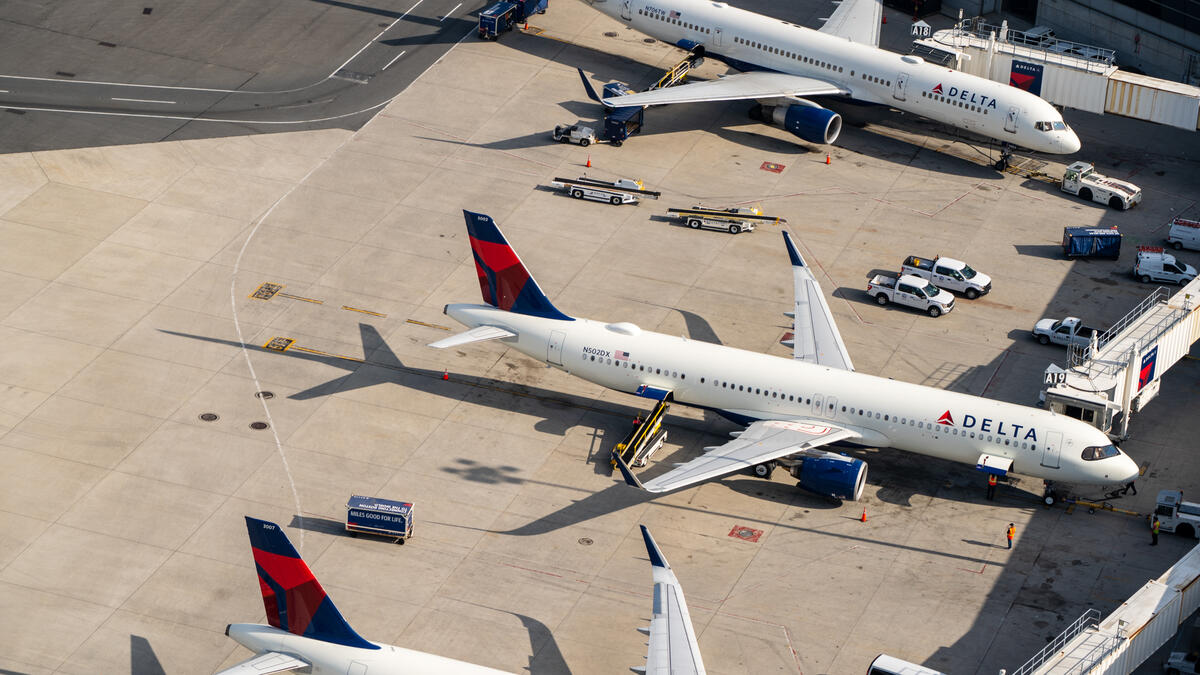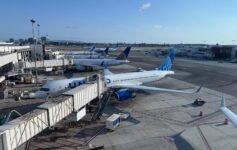
Delta Air Lines reported better-than-expected financial results for Q2 2025 quarter. Shares jumped more than 10% as the carrier reinstated full-year guidance and raised its quarterly dividend. Laissez les bons temps roule for Delta.
Delta Air Lines Posts Strong Q2 2025 Results, Stock Soars
In a nutshell, Delta’s performance beat analyst expectations and Delta’s own more modest forecast:
- international revenue +2%
- premium revenue +5%
- cargo revenue +7%
- fuel costs -11%,
- loyalty revenue +8%
- American Express revenue +10%
While 2025 is not expected to be a year of record profit, Delta now expects a healthy profit for the full fiscal year.
Delta Q2 2025 Adjusted Financial Results
Here’s a closer look at key metrics:
| Metric | Q2 2025 |
|---|---|
| Operating income | $2.048B |
| Operating margin | 13.2% |
| Pre-tax income | $1.805B |
| Pre-tax margin | 11.6% |
| Net income | $1.370B |
| Diluted earnings per share | $2.10 |
| Operating revenue | $15.507B |
| TRASM (cents) | 19.97 |
| Operating expense | $13.458B |
| Non-fuel cost | $10.476B |
| Non-fuel unit cost (CASM-Ex) | 13.49 cents |
| Fuel expense | $2.512B |
| Average fuel price per gallon | $2.26 |
| Operating cash flow | $1.844B |
| Free cash flow | $733M |
| Gross capital expenditures | $1.168B |
| Adjusted net debt | $16.316B |
Why It Matters
Delta’s adjusted earnings of $2.10 per share slightly topped Wall Street expectations of $2.06–$2.08. Revenue came in at $15.5 billion, up modestly year-over-year, but still strong given cost headwinds.
CEO Ed Bastian attributed the performance to premium cabin demand, loyalty revenue, and strength in international markets, particularly the Pacific region. Business travel held steady and capacity was carefully managed.
“In the June quarter, Delta delivered record revenue on a 13% operating margin, generating $1.8 billion in pre-tax profit and leading network peers across key operational metrics. This strong performance is a direct reflection of the outstanding contributions of our people, who continue to set the bar for industry performance.
“As we look to the second half of our centennial year, we remain focused on executing our strategic priorities and managing the levers within our control to deliver strong earnings and cash flow. Reflecting our confidence in the business, we are restoring financial guidance with an expectation for earnings per share of $5.25 to $6.25 and free cash flow of $3 to $4 billion, consistent with our long-term free cash flow targets.”
With greater clarity in the macroeconomic environment, Delta restored its full-year adjusted EPS guidance ($5.25–$6.25), projected $3–$4 billion in full-year free cash flow, and raised its quarterly dividend by 25%.
Market Reaction
Delta’s stock surged 12% on the news, and the broader airline sector followed. While earnings were down compared to the same quarter last year, the beat on revenue and return of full-year guidance were seen as strong positives by investors and perhaps a sign that, despite a trade war and harsh rhetoric that may have dampened inbound demand in the USA, international travel remains quite resilient.
Looking Ahead
For Q3, Delta is guiding adjusted EPS between $1.25 and $1.75. Revenue is expected to be flat to up 4% year-over-year. The airline continues to lean into its premium-focused model and long-haul international flying as a hedge against softening domestic main cabin demand.
CONCLUSION
Delta didn’t post record profits in Q2, but the quarter demonstrated disciplined management, strong execution, and investor confidence. With its dividend raised and long-term guidance back in play, Delta is showing why its business model of premium service and loyalty monetization continues to outperform.




With DL “unbundling” J sometime soon, they have a good excuse for a lower performance in a future quarter if it doesn’t go to plan.
But, but, but the Tariffs
But, but, but the Foreigners are boycotting us.
But, but, but the US economy is crashing
Meanwhile some of us just keep making easy money by betting ON the US Economy regardless of who is the President. God Bless our CEO’s, worth every dollar!
Especially helpful for the share price increase , was the decision to stop serving drinks to SLC passengers .
Especially those on the way to Cancun . They got free positive publicity out of that .
CONCLUSION
“Delta didn’t post record profits in Q2, but the quarter demonstrated disciplined management, strong execution, and investor confidence. With its dividend raised and long-term guidance back in play, Delta is showing why its business model of premium service and loyalty monetization continues to outperform.”
Less all that and more that gas was down 11% and tariffs didn’t cause a collapse of the economy and travel.
I wonder if the restored guidance is in a similar vein to the “TACO” phenomenon.
There’s still so much uncertainty with tariffs but the markets don’t really believe it anymore and Delta now seems to be restoring guidance in a similar way — threats of tariffs every day but the expectation of impact from them appears to be down — whether due to disbelief in their future reality or impact.
One of the biggest drivers in DL’s net income increase was a gain on its equity investments in other airlines that hurt it a year ago.
DL has adapted well to the changing demand environment while paying its employees at industry highs.
“And it’s so easy when you’re evil
This is the life, you see
The devil tips his hat to me
I do it all because I’m evil
And I do it all for free
Your tears are all the pay I’ll ever need” – Aurelio Voltaire
For almost a generation, Big D has demonstrated professionalism and expert financial skills. United is trying to catch up but Delta, from a strong base, will continue to outperform it’s peers, maybe for another generation.
United has to settle the six open union contracts it has right now. It will either trim its earnings substantially or face a much less happy workforce.
AA, DL and WN all pay (including benefits) its non-pilot employees more than UA does.
Beside the FAs, UA mechanics are not at all happy w/ what the company has offered.
both groups can be very influential in making their voices known.
When UA resolves its pay discrepancies, one way or another, we can begin to make comparisons to other airlines.
Since credit cards make up such a significant revenue and profit vehicle, would like to see these broken out and separate from the rest of the quarterly and annual numbers. This would justified by accounting principles that major sources of revenue and expense are identified in separate line items.
I know the airlines would fight this tooth and nail, but would take away the mystery of whether airlines are making any money off of flights and network as opposed to credit cards and loyalty programs.
I say this because DL projects $8B in credit card profit. Yet, the profit for 2Q is 2.0B. The impression is that credit cards are propping up the rest of the system. That’s why JetBlue is looking for a partner to transform its TrueBlue program into a cash cow via alliances. Also, I just took a trip to Berlin. On each of the four legs of the trip, an announcement was made hawking the United credit card.
In the movie The Graduate, Benjamin is told “plastics” were the future.
If there was ever a sequel, Benjamin would be told “credit cards” would be the future!